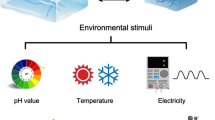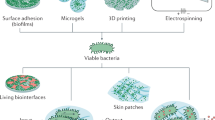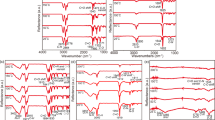Abstract
In nature, interfacial molecular interactions are at the heart of all biological processes and are mediated by diverse stimuli. Inspired by nature's responsive mechanisms and our increased capability to manipulate matter at the molecular level, new bio-interface materials are being developed that respond efficiently to a variety of external stimuli. In this Review, we discuss emerging methods for imparting surfaces with dynamic properties and how this, in turn, is leading to increased functional complexity at the bio-interface. We examine how recent advances are becoming important in providing new insights into cell behaviour and spurring substantial progress in the fields of regenerative medicine and tissue engineering. These advances provide new opportunities to address the complex issues associated with biofouling and facilitate the production of implantable on-demand sensing devices and highly effective delivery, bioseparation and bioelectrocatalytic systems. Although progress is being made, we also highlight that current methods are still limited in their capability to impart complex functionality onto the bio-interface to fully address the current challenges in biotechnology and biomedicine. Exciting prospects include the incorporation of full reversibility of interactions, a broad repertoire of multi-responsiveness and bidirectional actuation at the bio-interface, as well as the capability to incorporate the developed systems in practical applications.
This is a preview of subscription content, access via your institution
Access options
Access Nature and 54 other Nature Portfolio journals
Get Nature+, our best-value online-access subscription
$29.99 / 30 days
cancel any time
Subscribe to this journal
Receive 12 digital issues and online access to articles
$119.00 per year
only $9.92 per issue
Buy this article
- Purchase on Springer Link
- Instant access to full article PDF
Prices may be subject to local taxes which are calculated during checkout







Similar content being viewed by others
References
Mendes, P. M. Stimuli-responsive surfaces for bio-applications. Chem. Soc. Rev. 37, 2512–2529 (2008).
Mendes, P. M. Cellular nanotechnology: making biological interfaces smarter. Chem. Soc. Rev. 42, 9207–9218 (2013).
Pranzetti, A. et al. An electrically reversible switchable surface to control and study early bacterial adhesion dynamics in real-time. Adv. Mater. 25, 2181–2185 (2013).
Epstein, A. K., Hong, D., Kim, P. & Aizenberg, J. Biofilm attachment reduction on bioinspired, dynamic, micro-wrinkling surfaces. New J. Phys. 15, 095018 (2013).
Shastri, A. et al. An aptamer-functionalized chemomechanically modulated biomolecule catch-and-release system. Nat. Chem. 7, 447–454 (2015).
Ashaduzzaman, M. et al. Studies on an on/off-switchable immunosensor for troponin T. Biosens. Bioelectron. 73, 100–107 (2015).
Parlak, O. et al. Programmable bioelectronics in a stimuli-encoded 3D graphene interface. Nanoscale 8, 9976–9981 (2016).
Patra, H. K. et al. On/off-switchable anti-neoplastic nanoarchitecture. Sci. Rep. 5, 14571 (2015).
Gao, H. et al. Near-infrared light-triggered switchable nanoparticles for targeted chemo/photothermal cancer therapy. ACS Appl. Mater. Interfaces 8, 15103–15112 (2016).
Patra, H. K. et al. MRI-visual order-disorder micellar nanostructures for smart cancer theranostics. Adv. Healthc. Mater. 3, 526–535 (2014).
Tompa, P. The principle of conformational signaling. Chem. Soc. Rev. 45, 4252–4284 (2016).
Keskin, O., Tuncbag, N. & Gursoy, A. Predicting protein-protein interactions from the molecular to the proteome level. Chem. Rev. 116, 4884–4909 (2016).
Ghitti, M., Musco, G. & Spitaleri, A. in Protein Conformational Dynamics Vol. 805 Advances in Experimental Medicine and Biology (eds Han, K. L., Zhang, X. & Yang, M. J. ) 271–329 (Springer-Verlag, Berlin, Germany, 2014).
Janowska, M. K., Wu, K. P. & Baum, J. Unveiling transient protein-protein interactions that modulate inhibition of alpha-synuclein aggregation by beta-synuclein, a pre-synaptic protein that co-localizes with alpha-synuclein. Sci. Rep. 5, 15164 (2015).
Rudolph, J. Inhibiting transient protein-protein interactions: lessons from the Cdc25 protein tyrosine phosphatases. Nat. Rev. Cancer 7, 202–211 (2007).
Petta, I., Lievens, S., Libert, C., Tavernier, J. & De Bosscher, K. Modulation of protein-protein interactions for the development of novel therapeutics. Mol. Ther. 24, 707–718 (2016).
Shimizu, Y., Boehm, H., Yamaguchi, K., Spatz, J. P. & Nakanishi, J. A photoactivatable nanopatterned substrate for analyzing collective cell migration with precisely tuned cell-extracellular matrix ligand interactions. PLOS ONE 9, e91875 (2014).
Lee, E. J., Luo, W., Chan, E. W. & Yousaf, M. N. A molecular smart surface for spatio-temporal studies of cell mobility. PLOS ONE 10, e0118126 (2015).
Jeon, G., Yang, S. Y., Byun, J. & Kim, J. K. Electrically actuatable smart nanoporous membrane for pulsatile drug release. Nano Lett. 11, 1284–1288 (2011).
Wan, P. B. & Chen, X. D. Stimuli-responsive supramolecular interfaces for controllable bioelectrocatalysis. ChemElectroChem 1, 1602–1612 (2014).
Hyun, J., Lee, W. K., Nath, N., Chilkoti, A. & Zauscher, S. Capture and release of proteins on the nanoscale by stimuli-responsive elastin-like polypeptide “switches”. J. Am. Chem. Soc. 126, 7330–7335 (2004).
Megeed, Z., Winters, R. M. & Yarmush, M. L. Modulation of single-chain antibody affinity with temperature-responsive elastin-like polypeptide linkers. Biomacromolecules 7, 999–1004 (2006).
Cantini, E. et al. Electrically responsive surfaces: experimental and theoretical investigations. Acc. Chem. Res. 49, 1223–1231 (2016).
Pivetal, J. et al. Micro-magnet arrays for specific single bacterial cell positioning. J. Magn. Magn. Mater. 380, 72–77 (2015).
Polte, T. R. et al. Nanostructured magnetizable materials that switch cells between life and death. Biomaterials 28, 2783–2790 (2007).
Mertz, D. et al. Mechanotransductive surfaces for reversible biocatalysis activation. Nat. Mater. 8, 731–735 (2009).
Kadem, L. F. et al. Rapid reversible photoswitching of integrin-mediated adhesion at the single-cell level. Adv. Mater. 28, 1799–1802 (2016).
Giner-Casares, J. J., Henriksen-Lacey, M., Garcia, I. & Liz-Marzan, L. M. Plasmonic surfaces for cell growth and retrieval triggered by near-infrared light. Angew. Chem. Int. Ed. 55, 974–978 (2016).
Yu, Q. et al. Nanopatterned polymer brushes as switchable bioactive interfaces. Nanoscale 5, 3632–3637 (2013).
Liu, H. L. et al. Hydrophobic interaction-mediated capture and release of cancer cells on thermoresponsive nanostructured surfaces. Adv. Mater. 25, 922–927 (2013).
Wei, T., Yu, Q., Zhan, W. & Chen, H. A smart antibacterial surface for the on-demand killing and releasing of bacteria. Adv. Healthcare Mater. 5, 449–456 (2016).
Gensel, J. et al. Cavitation engineered 3D sponge networks and their application in active surface construction. Adv. Mater. 24, 985–959 (2012).
Srinivasan, N., Bhagawati, M., Ananthanarayanan, B. & Kumar, S. Stimuli-sensitive intrinsically disordered protein brushes. Nat. Commun. 5, 5145 (2014).
Wang, S. et al. DNA orientation-specific adhesion and patterning of living mammalian cells on self-assembled DNA monolayers. Chem. Sci. 7, 2722–2727 (2016).
Pan, G. et al. Dynamic introduction of cell adhesive factor via reversible multicovalent phenylboronic acid/cis-diol polymeric complexes. J. Am. Chem. Soc. 136, 6203–6206 (2014).
Lutolf, M. P. et al. Synthetic matrix metalloproteinase-sensitive hydrogels for the conduction of tissue regeneration: engineering cell-invasion characteristics. Proc. Natl Acad. Sci. USA 100, 5413–5418 (2003).
Zelzer, M. et al. Phosphatase responsive peptide surfaces. J. Mater. Chem. 22, 12229–12237 (2012).
Richardson, J. J., Bjornmalm, M. & Caruso, F. Multilayer assembly. Technology-driven layer-by-layer assembly of nanofilms. Science 348, aaa2491 (2015).
Paul, N. et al. Molecularly imprinted conductive polymers for controlled trafficking of neurotransmitters at solid–liquid interfaces. Soft Matter 9, 1364–1371 (2012).
Xia, D. Y., Ku, Z. Y., Lee, S. C. & Brueck, S. R. J. Nanostructures and functional materials fabricated by interferometric lithography. Adv. Mater. 23, 147–179 (2011).
Glass, R., Moller, M. & Spatz, J. P. Block copolymer micelle nanolithography. Nanotechnology 14, 1153–1160 (2003).
Lohmuller, T. et al. Nanopatterning by block copolymer micelle nanolithography and bioinspired applications. Biointerphases 6, MR1–MR12 (2011).
Osypova, A. et al. Dual stimuli-responsive coating designed through layer-by-layer assembly of PAA-b-PNIPAM block copolymers for the control of protein adsorption. Soft Matter 11, 8154–8164 (2015).
Kaniewska, K., Karbarz, M. & Stojek, Z. Electrochemical attachment of thermo- and pH-sensitive interpenetrating-polymers-network hydrogel to conducting surface. Electrochim. Acta 179, 372–378 (2015).
An, X. N. et al. Rational design of multi-stimuli-responsive nanoparticles for precise cancer therapy. ACS Nano 10, 5947–5958 (2016).
Okano, T., Yamada, N., Sakai, H. & Sakurai, Y. A novel recoverv svstern for cultured cells using plasrna-trGatid polystyrene dishes grafted with poly(N-isopropylacrylarnide). J. Biomed. Mater. Res. 27, 1243–1251 (1993).
Lashkor, M., Rawson, F. J., Stephenson-Brown, A., Preece, J. A. & Mendes, P. M. Electrically-driven modulation of surface-grafted rgd peptides for manipulation of cell adhesion. Chem. Commun. 50, 15589–15592 (2014).
Parthasarathy, P. et al. Spatially controlled assembly of nanomaterials at the nanoscale. J. Nanosci. Nanotechnol. 9, 650–654 (2009).
Blonder, R., Katz, E., Willner, I., Wray, V. & Buckmann, A. F. Application of a nitrospiropyran-FAD-reconstituted glucose oxidase and charged electron mediators as optobioelectronic assemblies for the amperometric transduction of recorded optical signals: control of the ‘’on’’–’’off’’ direction of the photoswitch. J. Am. Chem. Soc. 119, 11747–11757 (1997).
Wan, P., Chen, Y., Xing, Y., Chi, L. & Zhang, X. Combining host-guest systems with nonfouling material for the fabrication of a biosurface: toward nearly complete and reversible resistance of cytochrome c. Langmuir 26, 12515–12517 (2010).
Yeung, C. L. et al. Tuning specific biomolecular interactions using electro-switchable oligopeptide surfaces. Adv. Funct. Mater. 20, 2657–2663 (2010).
You, J. et al. Noninvasive photodetachment of stem cells on tunable conductive polymer nano thin films: selective harvesting and preserved differentiation capacity. ACS Nano 7, 4119–4128 (2013).
Ng, C. C. A. et al. Using an electrical potential to reversibly switch surfaces between two states for dynamically controlling cell adhesion. Angew. Chem. Int. Ed. 51, 7706–7710 (2012).
Murase, Y., Maeda, S., Hashimoto, S. & Yoshida, R. Design of a mass transport surface utilizing peristaltic motion of a self-oscillating gel. Langmuir 25, 483–489 (2009).
Suzuki, D., Kobayashi, T., Yoshida, R. & Hirai, T. Soft actuators of organized self-oscillating microgels. Soft Matter 8, 11447–11449 (2012).
Maeda, S., Hara, Y., Sakai, T., Yoshida, R. & Hashimoto, S. Self-walking gel. Adv. Mater. 19, 3480–3484 (2007).
Homma, K. et al. Fabrication of micropatterned self-oscillating polymer brush for direction control of chemical waves. Small 13, 8 (2017).
Chen, H. M., Zhang, W. Z., Zhu, G. Z., Xie, J. & Chen, X. Y. Rethinking cancer nanotheranostics. Nat. Rev. Mater. 2, 17024 (2017).
Baetke, S. C., Lammers, T. & Kiessling, F. Applications of nanoparticles for diagnosis and therapy of cancer. Br. J. Radiol. 88, 12 (2015).
Hatakeyama, H. Recent advances in endogenous and exogenous stimuli-responsive nanocarriers for drug delivery and therapeutics. Chem. Pharm. Bull. 65, 612–617 (2017).
Li, F. Y., Lu, J. X., Kong, X. Q., Hyeon, T. & Ling, D. S. Dynamic nanoparticle assemblies for biomedical applications. Adv. Mater. 29, 30 (2017).
Zhou, M. X. et al. The application of stimuli-responsive nanocarriers for targeted drug delivery. Curr. Top. Med. Chem. 17, 2319–2334 (2017).
Bjö rnmalm, M., Thurecht, K. J., Michael, M., Scott, A. M. & Caruso, F. Bridging bio–nano science and cancer nanomedicine. ACS Nano 11, 9594–9613 (2017).
MacEwan, S. R. & Chilkoti, A. From composition to cure: a systems engineering approach to anticancer drug carriers. Angew. Chem. Int. Ed. 56, 6712–6733 (2017).
Sneider, A., VanDyke, D., Paliwal, S. & Rai, P. Remotely triggered nano-theranostics for cancer applications. Nanotheranostics 1, 1–22 (2017).
Wang, J., Tao, W., Chen, X., Farokhzad, O. C. & Liu, G. Emerging advances in nanotheranostics with intelligent bioresponsive systems. Theranostics 7, 3915–3919 (2017).
Zhao, Y., Tavares, A. C. & Gauthier, M. A. Nano-engineered electro-responsive drug delivery systems. J. Mater. Chem. B 4, 3019–3030 (2016).
Uppalapati, D., Boyd, B. J., Garg, S., Travas-Sejdic, J. & Svirskis, D. Conducting polymers with defined micro- or nanostructures for drug delivery. Biomaterials 111, 149–162 (2016).
Seyfoddin, A. et al. Electro-responsive macroporous polypyrrole scaffolds for triggered dexamethasone delivery. Eur. J. Pharm. Biopharm. 94, 419–426 (2015).
Lorenzo, R. A., Carro, A. M., Concheiro, A. & Alvarez-Lorenzo, C. Stimuli-responsive materials in analytical separation. Anal. Bioanal. Chem. 407, 4927–4948 (2015).
Wegner, S. V., Sentü rk, O. I. & Spatz, J. P. Photocleavable linker for the patterning of bioactive molecules. Sci. Rep. 5, 18309 (2015).
Katz, E., Minko, S., Halamek, J., MacVittie, K. & Yancey, K. Electrode interfaces switchable by physical and chemical signals for biosensing, biofuel, and biocomputing applications. Anal. Bioanal. Chem. 405, 3659–3672 (2013).
Tam, T. K. et al. Biochemically controlled bioelectrocatalytic interface. J. Am. Chem. Soc. 130, 10888–10889 (2008).
Pita, M., Privman, M. & Katz, E. Biocatalytic enzyme networks designed for binary-logic control of smart electroactive nanobiointerfaces. Top. Catal. 55, 1201–1216 (2012).
Willner, I., Liondagan, M., Marxtibbon, S. & Katz, E. Bioelectrocatalyzed amperometric transduction of recorded optical signals using monolayer-modified au-electrodes. J. Am. Chem. Soc. 117, 6581–6592 (1995).
Willner, I. & Katz, E. Magnetic control of electrocatalytic and bioelectrocatalytic processes. Angew. Chem. Int. Ed. 42, 4576–4588 (2003).
Parlak, O., Turner, A. P. F. & Tiwari, A. On/Off-switchable zipper-like bioelectronics on a graphene interface. Adv. Mater. 26, 482–486 (2014).
Yao, H. et al. A stimuli-responsive biosensor of glucose on layer-by-layer films assembled through specific lectin-glycoenzyme recognition. Sensors 16, 563 (2016).
Parlak, O., Ashaduzzaman, M., Kollipara, S. B., Tiwari, A. & Turner, A. P. F. Switchable bioelectrocatalysis controlled by dual stimuli-responsive polymeric interface. ACS Appl. Mater. Interfaces 7, 23837–23847 (2015).
Patra, H. K. et al. Inflammation-sensitive in situ smart scaffolding for regenerative medicine. Nanoscale 8, 17213–17222 (2016).
Hirose, M., Kwon, O. H., Yamato, M., Kikuchi, A. & Okano, T. Creation of designed shape cell sheets that are noninvasively harvested and moved onto another surface. Biomacromolecules 1, 377–381 (2000).
Yamato, M., Konno, C., Utsumi, M., Kikuchi, A. & Okano, T. Thermally responsive polymer-grafted surfaces facilitate patterned cell seeding and co-culture. Biomaterials 23, 561–567 (2002).
Liu, H. et al. Dual-responsive surfaces modified with phenylboronic acid-containing polymer brush to reversibly capture and release cancer cells. J. Am. Chem. Soc. 135, 7603–7609 (2013).
Pan, G., Guo, Q., Ma, Y., Yang, H. & Li, B. Thermo-responsive hydrogel layers imprinted with RGDS peptide: a system for harvesting cell sheets. Angew. Chem. Int. Ed. 52, 6907–6911 (2013).
Desseaux, S. & Klok, H. Temperature-controlled masking/unmasking of cell-adhesive cues with poly(ethylene glycol) methacrylate based brushes. Biomacromolecules 15, 3859–3865 (2014).
Gong, Y. et al. Photoresponsive “smart template” via host guest interaction for reversible cell adhesion. Macromolecules 44, 7499–7502 (2011).
Goulet-Hanssens, A., Sun, K. L. W., Kennedy, T. E. & Barrett, C. J. Photoreversible surfaces to regulate cell adhesion. Biomacromolecules 13, 2958–2963 (2012).
Kadem, L. F. et al. High-frequency mechanostimulation of cell adhesion. Angew. Chem. Int. Ed. 56, 225–229 (2017).
Yu, Q., Johnson, L. M. & Ló pez, G. P. Nanopatterned polymer brushes for triggered detachment of anchorage-dependent cells. Adv. Funct. Mater. 24, 3751–3759 (2014).
Wan, A. M. et al. 3D conducting polymer platforms for electrical control of protein conformation and cellular functions. J. Mater. Chem. B 3, 5040–5048 (2015).
Kraehenbuehl, T. P. et al. Three-dimensional extracellular matrix-directed cardioprogenitor differentiation: systematic modulation of a synthetic cell-responsive PEG-hydrogel. Biomaterials 29, 2757–2766 (2008).
Wei, Y. et al. Directing stem cell differentiation via electrochemical reversible switching between nanotubes and nanotips of polypyrrole array. ACS Nano 11, 5915–5924 (2017).
Salvay, D. M. & Shea, L. D. Inductive tissue engineering with protein and DNA-releasing scaffolds. Mol. Biosyst. 2, 36–48 (2006).
Xiong, X. H. et al. Reversible bacterial adhesion on mixed poly(dimethylaminoethyl methacrylate)/poly(acrylamidophenyl boronic acid) brush surfaces. Langmuir 31, 12054–12060 (2015).
Yu, Q., Wu, Z. Q. & Chen, H. Dual-function antibacterial surfaces for biomedical applications. Acta Biomater. 16, 1–13 (2015).
Yu, Q., Cho, J., Shivapooja, P., Ista, L. K. & Lopez, G. P. Nanopatterned smart polymer surfaces for controlled attachment, killing, and release of bacteria. ACS Appl. Mater. Interfaces 5, 9295–9304 (2013).
Dong, Y. S., Xiong, X. H., Lu, X. W., Wu, Z. Q. & Chen, H. Antibacterial surfaces based on poly(cationic liquid) brushes: switchability between killing and releasing via anion counterion switching. J. Mater. Chem. B 4, 6111–6116 (2016).
Gushchin, I. et al. Mechanism of transmembrane signaling by sensor histidine kinases. Science 356, eaah6345 (2017).
Persat, A. Bacterial mechanotransduction. Curr. Opin. Microbiol. 36, 1–6 (2017).
Alsharif, G. et al. Host attachment and fluid shear are integrated into a mechanical signal regulating virulence in Escherichia coli O157:H7. Proc. Natl Acad. Sci. USA 112, 5503–5508 (2015).
Grinthal, A. & Aizenberg, J. Mobile interfaces: liquids as a perfect structural material for multifunctional, antifouling surfaces. Chem. Mat. 26, 698–708 (2014).
Sohka, T. et al. An externally tunable bacterial band-pass filter. Proc. Natl Acad. Sci. USA 106, 10135–10140 (2009).
Acknowledgements
The authors acknowledge financial support for this work from the Engineering and Physical Sciences Research Council (EPSRC; EP/K027263/1) and the European Research Council (ERC; Consolidator Grant 614787).
Author information
Authors and Affiliations
Contributions
All authors contributed to researching data for the article and writing, reviewing and editing the article before submission.
Corresponding author
Ethics declarations
Competing interests
The authors declare no competing interests.
Glossary
- Theranostics
-
The combination of therapeutic and diagnostic capabilities in the same system.
- Bioelectrocatalysis
-
The use of materials derived from biological systems as catalysts for electrochemical processes.
- Molecular imprinting
-
The construction of selective recognition sites in polymeric materials, where a target template is employed to facilitate recognition site formation.
- Addressability
-
The capability to apply a specific stimulus.
Rights and permissions
About this article
Cite this article
Gomes, B., Simões, B. & Mendes, P. The increasing dynamic, functional complexity of bio-interface materials. Nat Rev Chem 2, 0120 (2018). https://doi.org/10.1038/s41570-018-0120
Published:
DOI: https://doi.org/10.1038/s41570-018-0120
This article is cited by
-
Sticky gels designed for tissue-healing therapies and diagnostics
Nature (2024)
-
Recent Innovations in the Strategies for the Functionalization of Chitosan, Pectin, Alginate, Hyaluronic Acid, Dextran and Inulin Biomaterials for Anticancer Applications-A Review
Journal of Polymers and the Environment (2023)
-
Grafting of short elastin-like peptides using an electric field
Scientific Reports (2022)
-
Cell-repellent polyampholyte for conformal coating on microstructures
Scientific Reports (2022)
-
Improving bactericidal performance of implant composite coatings by synergism between Melittin and tetracycline
Journal of Materials Science: Materials in Medicine (2022)



